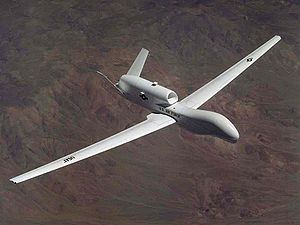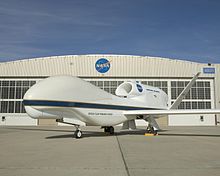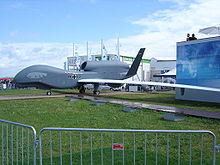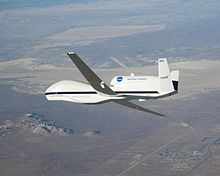- Northrop Grumman RQ-4 Global Hawk
-
RQ-4/MQ-4 Global Hawk Role Surveillance UAV National origin United States Manufacturer Northrop Grumman Primary users United States Air Force
United States Navy
NASAProgram cost US$1,635.4 million[1] Unit cost US$200 millions (system includes 1 aircraft (178 US$millions/aircraft[1][2]), ground control stations, and Primary Satellite Link) Variants Scaled Composites Model 396 The Northrop Grumman (formerly Ryan Aeronautical) RQ-4 Global Hawk (known as Tier II+ during development) is an unmanned aerial vehicle (UAV) used by the United States Air Force and Navy as a surveillance aircraft.
In role and operational design, the Global Hawk is similar to the Lockheed U-2, the venerable 1950s spy plane. It is a theater commander's asset to provide a broad overview and systematic target surveillance. For this purpose, the Global Hawk is able to provide high resolution Synthetic Aperture Radar (SAR)—that can penetrate cloud-cover and sandstorms— and Electro-Optical/Infrared (EO/IR) imagery at long range with long loiter times over target areas. It can survey as much as 40,000 square miles (103,600 square kilometers) of terrain a day.
It is used as a high-altitude platform for surveillance and security. Missions for the Global Hawk cover the spectrum of intelligence collection capability to support forces in worldwide military operations. According to the Air Force, the capabilities of the aircraft allow more precise targeting of weapons and better protection of forces through superior surveillance capabilities.
The Global Hawk costs about US$35 million[3] (actual per-aircraft costs; with development costs also included, the per-aircraft cost rises to US$218 million each[4]).
Contents
Development
Initial development
The first seven aircraft were built under the Advanced Concept Technology Demonstration (ACTD) program, sponsored by DARPA,[5] in order to evaluate the design and its capabilities. Due to world circumstances, the capabilities of the aircraft were in high demand, so the prototype aircraft were operated by the U.S. Air Force in the War in Afghanistan.
 A maintenance crew prepares a Global Hawk for a test at Beale Air Force Base
A maintenance crew prepares a Global Hawk for a test at Beale Air Force Base
In an unusual move, the aircraft entered initial low-rate production concurrently while still in engineering and manufacturing development. Nine production Block 10 aircraft (sometimes referred to as RQ-4A configuration) were produced, two of which were sold to the US Navy. Two more were sent to Iraq to support operations there. The final Block 10 aircraft was delivered on June 26, 2006.[6]
In order to increase the aircraft's capabilities, the airframe was redesigned, with the nose section and wings being stretched. The changes, with the designation RQ-4B Block 20,[7] allow the aircraft to carry up to 3,000 pounds of internal payload. These changes were introduced with the first Block 20 aircraft, the 17th Global Hawk produced, which was rolled out in a ceremony on August 25, 2006.[8] First flight of the Block 20 from the USAF Plant 42 in Palmdale, California to Edwards Air Force Base took place on March 1, 2007. Developmental testing of Block 20 took place in 2008. Future Block 30 and 40 aircraft, similar in size to the Block 20, are scheduled for development from 2008 to 2010.[9] When the Global Hawk was produced it was in a sale plan for more than 5 countries including USA and Germany.[when?]
Cost overruns
Program development cost overruns had put the Global Hawk system at risk of cancellation. Per-unit costs in mid-2006 were 25% over baseline estimates, caused by both the need to correct design deficiencies as well as increase the system's capabilities. This caused some concerns about a possible congressional termination of the program if its national security benefits could not be justified.[10][11] However, in June 2006, the Global Hawk program was restructured. Completion of an operational assessment report by the Air Force was delayed from August 2005 to November 2007 due to manufacturing and development delays. The operational assessment report was released in March 2007 and production of the 54 air vehicles planned has been extended by two years to 2015.[12]
The Defense Department’s Director, Operational Test and Evaluation (DOT&E) found the RQ-4B "not operationally effective" for its mission due to unreliability of the airframe.[13]
The United States Navy took delivery of two of the Block 10 aircraft to be used to evaluate maritime surveillance capabilities, designated N-1 (BuNo 166509) and N-2 (BuNo 166510).[14] The initial example was tested in a naval configuration at Edwards Air Force Base for several months, later ferrying to NAS Patuxent River on March 28, 2006 to begin the Global Hawk Maritime Demonstration (GHMD) program. Navy squadron VX-20 was tasked with operating the GHMD system.[15][16]
The GHMD aircraft flew in the Rim of the Pacific (RIMPAC) exercise for the first time in July 2006. Although RIMPAC operations were in the vicinity of Hawaii, the aircraft was operated from Edwards, requiring flights of approximately 2,500 miles (4,000 km) each way to the operations area. Four flights were performed, resulting in over 24 hours of persistent maritime surveillance coordinated with USS Abraham Lincoln and USS Bonhomme Richard. As a part of the demonstration program, Global Hawk was tasked with maintenance of maritime situational awareness, contact tracking, and imagery support of various exercise operations. The imagery obtained by Global Hawk was transmitted to NAS Patuxent River for processing before being forwarded on to the fleet operations off Hawaii, thus exercising the global nature of this aircraft's operations.[17]
Northrop Grumman entered a version of the RQ-4B in the US Navy's Broad Area Maritime Surveillance (BAMS) UAV contract competition. On 22 April 2008 the announcement was made that the Northrop Grumman RQ-4N had won the bid, with the Navy awarding a contract worth US$1.16 billion.[18] In September 2010, the RQ-4N was officially designated the MQ-4C.[19]
Design
The RQ-4 is powered by an Allison Rolls-Royce AE3007H turbofan engine with 7,050 lbf (31.4 kN) thrust, and carries a payload of 2,000 pounds (900 kilograms). The main fuselage is standard aluminum, semi-monocoque construction, while the wings are made of lightweight, high-strength composite materials.[20]
Integrated system
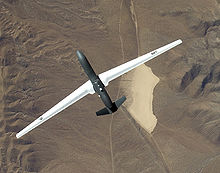 The Global Hawk's wings, fairings, nacelles, and tails are manufactured from high strength-to-weight ratio composites.
The Global Hawk's wings, fairings, nacelles, and tails are manufactured from high strength-to-weight ratio composites.
The Global Hawk UAV system comprises an air vehicle segment consisting of air vehicles with sensor payloads, avionics, and data links; a ground segment consisting of a Launch and Recovery Element (LRE), and a Mission Control Element (MCE) with embedded ground communications equipment; a support element; and trained personnel.
The Integrated Sensor Suite (ISS) is provided by Raytheon and consists of a synthetic aperture radar (SAR), electro-optical (EO), and infrared (IR) sensors. Either the EO or the IR sensors can operate simultaneously with the SAR. Each of the sensors provides wide area search imagery and a high-resolution spot mode. The SAR has a ground moving target indicator (GMTI) mode, which can provide a text message providing the moving target's position and velocity. Both SAR and EO/IR imagery are processed onboard the aircraft and transmitted to the MCE as individual frames. The MCE can mosaic these frames into images prior to further dissemination.
Navigation is via inertial navigation with integrated Global Positioning System updates. Global Hawk is intended to operate autonomously and "untethered" using a satellite data link (either Ku or UHF) for sending sensor data from the aircraft to the MCE. The common data link can also be used for direct down link of imagery when the UAV is operating within line-of-sight of users with compatible ground stations.
The ground segment consists of a Mission Control Element (MCE) and Launch and Recovery Element (LRE), provided by Raytheon. The MCE is used for mission planning, command and control, and image processing and dissemination; an LRE for controlling launch and recovery; and associated ground support equipment. (The LRE provides precision differential global positioning system corrections for navigational accuracy during takeoff and landings, while precision coded GPS supplemented with an inertial navigation system is used during mission execution.) By having separable elements in the ground segment, the MCE and the LRE can operate in geographically separate locations, and the MCE can be deployed with the supported command's primary exploitation site. Both ground segments are contained in military shelters with external antennas for line-of-sight and satellite communications with the air vehicles.
Sensor packages
The Global Hawk carries the "Hughes Integrated Surveillance & Reconnaissance (HISAR)" sensor system. HISAR is a lower-cost derivative of the ASARS-2 package that Hughes developed for the Lockheed U-2. HISAR is also fitted in the US Army's RC-7B Airborne Reconnaissance Low Multifunction (ARLM) manned surveillance aircraft, and is being sold on the international market. HISAR integrates a SAR-MTI system, along with an optical and an infrared imager. All three sensors are controlled and their outputs filtered by a common processor. The digital sensor data can be transmitted at up to 50 Mbit/s to a ground station in real time, either directly or through a communications satellite link.
The SAR-MTI system operates in the X-band and provides a number of operational modes:
- The wide-area MTI mode can detect moving targets within a radius of 62 miles (100 kilometers).
- The combined SAR-MTI strip mode provides 20 foot (6 meter) resolution over a swath 23 miles (37 kilometers) wide at ranges from 12.4 to 68 miles (20 to 110 kilometers).
- The SAR spot mode can provide 6 foot (1.8 meter) resolution over 3.8 square miles (10 square kilometers), as well as provide a sea-surveillance function.
The visible and infrared imagers share the same gimballed sensor package, and use common optics, providing a telescopic close-up capability. It can be optionally fitted with an auxiliary SIGINT package. To improve survivability, the Global Hawk is fitted with a Raytheon developed AN/ALR-89 self-protection suite consisting of the AN/AVR-3 Laser Warning System, AN/APR-49 Radar Warning Receiver and a jamming system. An ALE-50 towed decoy also aids in the Global Hawk's deception of enemy air defenses.[21][22]
In July 2006, the US Air Force began testing segments of the improved Global Hawk Block 30 upgrades in the Benefield Anechoic Facility at Edwards AFB. This version incorporates an extremely sensitive SIGINT processor known as the Advanced Signals Intelligence Payload.[21]
In September 2006, testing began on a new specialty radar system, the Multi-Platform Radar Technology Insertion Program, or MP-RTIP, onboard the Scaled Composites Proteus. Once validated, one Global Hawk will be modified to carry this radar set. Previously, the Air Force was considering a larger variant of the MP-RTIP (known as the Wide-Area Surveillance or WAS sensor) for the cancelled E-10 MC2A testbed or E-8 Joint STARS aircraft.
In August 2010, Northrop announced that a new version, block 40, was about to commence production; it would have a new sensor capabilities, including MP-RTIP radar, emphasising surveillance over reconnaissance. The Block 40 design also has a modified undercarriage.[23] In February 2011 the Air Force reduced its planned buy of RQ-4 Block 40 aircraft from 22 to 11 in a cost-cutting move.[24]
Operational history
U.S. Air Force
RQ-4 Global Hawk USAF video
Air Force Global Hawk flight test evaluations are performed by the 452nd Flight Test Squadron at Edwards AFB. Operational USAF aircraft are flown by the 9th Reconnaissance Wing, 12th Reconnaissance Squadron at Beale Air Force Base.
Global Hawk ATCD prototypes have been used in the War in Afghanistan and in the Iraq War. Since April 2010, they fly the Northern Route, from Beale AFB over Canada to South-East Asia and back, reducing flight time and improving maintenance. While their data-collection capabilities have been praised, the program did lose three prototype aircraft, more than one quarter of the aircraft used in the wars, being lost. According to Australian press reports, the crashes were due to "technical failures or poor maintenance", with a failure rate per hour flown over 100 times higher than the F-16 fighters flown in the same wars. The manufacturer stated that it was unfair to compare the failure rates of a mature design to that of a prototype plane.
The US military is said to be planning an unmanned Global Hawk aircraft flight to scope out the No.4 reactor at the Fukushima nuclear plant in Japan.[25]
Three Global Hawks have been lost in accidents.[26][27][28]
Records
On March 21, 2001, aircraft number 982003, the third ACTD aircraft produced, set an official world endurance record for UAVs, at 30 hours, 24 minutes and 1 second, flying from Edwards.[29] During the same flight, it set an absolute altitude record of 19,928 meters (65,381 ft), which was later broken by the NASA Helios Prototype (although the absolute record was broken, the Global Hawk's record still stands in its FAI class category).[30]
On April 24, 2001 a Global Hawk flew non-stop from Edwards in the US to RAAF Base Edinburgh in Australia, making history by being the first pilotless aircraft to cross the Pacific Ocean. The flight took 22 hours, and set a world record for absolute distance flown by a UAV, 13,219.86 kilometers (8,214.44 mi).[31][32]
On February 11, 2010 the Global Hawks deployed in the Central Command AOR accrued 30,000 combat hours and 1,500 plus sorties.[33]
NASA
In December 2007, two Global Hawks were transferred from the U.S. Air Force to NASA's Dryden Flight Research Center at Edwards Air Force Base. Initial research activities beginning in the second quarter of 2009 supported NASA's high-altitude, long-duration Earth science missions.[34][35] The three Global Hawks were the first,sixth and seventh aircraft built under the original DARPA Advanced Concept Technology Demonstration program, and were made available to NASA when the Air Force had no further need for them.[5] Northrop Grumman is an operational partner with NASA and will use the aircraft to demonstrate new technologies and to develop new markets for the aircraft, including possible civilian uses.[35]
According to an article in the March 2010 issue of Scientific American (p. 25-27), the Global Hawk aircraft belonging to NASA were in use for testing purposes as of October 2009, with science missions expected to start in March 2010. Initial science applications included measurements of the ozone layer and cross-Pacific transport of air pollutants and aerosols. The author of the Scientific American piece speculates that the aircraft could be used for Antarctic exploration while based in and operated from Chile.
In August and September 2010 one of the two Global Hawks was loaned for NASA's GRIP Mission (Genesis and Rapid Intensification Program),[36] with its long-term on station capabilities and long range it was the best aircraft for the mission to monitor the development of Atlantic basin Hurricanes. It was modified to equip weather sensors including Ku-Band Radar, Lightning sensors and Dropsondes.[37] It successfully flew into Hurricane Earl off the United States East Coast on September 2.[38]
NATO
NATO has announced that it expects to have a fleet of up to eight Global Hawks by the year 2012. The aircraft are to be equipped with MP-RTIP radar systems. NATO has budgeted US$1.4 billion (€1 billion) for the project, and a letter of intent has been signed, although contracting with Northrop Grumman has not been finalized.[39]
Luftwaffe
The German Luftwaffe has ordered a variant of the RQ-4B equipped with German sensors, dubbed EuroHawk. It combines a normal RQ-4B airframe with an EADS reconnaissance payload.
The aircraft is based on the Block 20/30/40 RQ-4B, but will be equipped with EADS' SIGINT package to fulfil Germany's desire to replace their aging Dassault-Breguet Atlantique electronic surveillance aircraft.[40] That sensor package comes in the form of six wing mounted pods, a first for the Global Hawk. The EuroHawk was officially rolled out on October 8, 2009 and first flight took place on June 29, 2010.[41] It underwent several months of flight testing at Edwards Air Force Base before flying to Germany.[42] On July 21, 2011, the first EuroHawk arrived in Manching, Germany where it will be equipped with the SIGINT sensor package. There it is also slated to undergo more testing and pilot training, until the first quarter of 2012, when it will be officially handed over to the Luftwaffe to be stationed with the Reconnaissance Wing 51.[43]
The costs for the initial five aircraft are approx. €430 million for the development, and €430 million for the actual procurement.
Potential operators
Australia considered the purchase of a number of Global Hawk aircraft for maritime and land surveillance. The Global Hawk was to be assessed against the MQ-9 Mariner in trials in 2007.[44] The Global Hawk aircraft would have operated in conjunction with manned P-8A Poseidon aircraft by 10 and 11 Squadrons of the RAAF. This combination, or a similar one, was to replace existing AP-3C Orion aircraft in 2018. In the end, the Australian government decided not to proceed with this plan and cancelled the order.[45]
Canada was also a potential customer, looking at the Global Hawk for maritime and land surveillance as either a replacement for its fleet of CP-140 Aurora patrol aircraft or to supplement manned patrols of remote Arctic and maritime environments, before withdrawing from the joint effort in August 2011.[46] Spain has a similar requirement, and has existing contacts with Northrop Grumman.[47]
Japan has been reported as being interested in the purchase of three aircraft.[48][49]
South Korea's Defense Acquisition Program Administration (DAPA) had expressed interest in acquiring at least four RQ-4B and support equipment by 2011 to increase the intelligence capabilities of the South Korean military after the return of the Wartime Operational Control from the U.S. to ROK, and has allocated approximately US$19 million for evaluation purposes.[citation needed] There is ongoing debate among government officials on whether to take the US offer of Global Hawks or to press on with their domestic UAV development program.[citation needed] South Korea expects to sign a preliminary contract for the aircraft by the end of 2011.[50] In Sep 2011, The U.S. defense department started conversation with South Korea to deploy the RQ-4 Global Hawk surveillance drone near its border with North Korea. It is believed that this would allow for an enhanced view of North Korea and China. This aircraft’s cameras and sensors are able to pick up target information well beyond the Yalu River, which is where the border between North Korea and China lies.[51]
New Zealand's Defence Force is keeping a "watching brief" over Global Hawk, which has the range to conduct surveillance in the Southern Ocean around Antarctica, and in the Pacific Islands.[citation needed] At the moment the acquisition process has moved no further than an expression of interest. Also being looked at are the IAI Heron and a natively-developed hand-thrown drone, the "Kahu".[citation needed]
The Indian Navy has expressed interest in MQ-4C Maritime Surveillance Unmanned Aircraft Systems.[52]
Variants
- RQ-4A
- Initial production version for the USAF, 16 built.
- RQ-4B
- Improved version with increased payload, wingspan increased to 130.9 ft (39.8m) and length increased to 47.7 ft (14.5m), due to the increased size and payload the range is reduced to 8,700 nm[53]
- RQ-4E
- German Euro Hawk, based on RQ-4B. Equipped with an EADS reconnaissance payload in SIGINT role.
- MQ-4C
- For USN Broad Area Maritime Surveillance role; previously known as the RQ-4N.
- KQ-4
- Proposed autonomous tanker, currently being tested.[54]
- EQ-4B
- Equipped with the Battlefield Airborne Communications Node (BACN) system[55]
Miniature variant
Scaled Composites and Northrop Grumman also offered a 50% proportional shrink of the RQ-4A, currently known as the Model 396, as part of the USAF Hunter-Killer program.
Operators
Specifications (RQ-4A)
General characteristics
- Crew: 0
- Length: 44 ft 5 in (13.54 m)
- Wingspan: 116 ft 2 in (35.41 m)
- Height: 15 ft 2 in (4.62 m)
- Empty weight: 8,490 lb (3,851 kg)
- Gross weight: 22,900 lb (10,387 kg)
- Powerplant: 1 × Allison Rolls-Royce AE3007H turbofan engine, 7,050 lbf (31.4 kN) thrust
Performance
- Maximum speed: 497.1 mph (800.0 km/h; 432.0 kn)
- Cruise speed: 404 mph (351 kn; 650 km/h)
- Range: 15,525 mi (13,491 nmi; 24,985 km)
- Endurance: 36 hours
- Service ceiling: 65,000 ft (19,812 m)
See also
- Related development
- Aircraft of comparable role, configuration and era
- RQ-3 DarkStar
- MQ-9 Reaper
- Guizhou Soar Eagle
- IAI Eitan
- Related lists
References
- ^ a b http://costofwar.com/en/publications/2011/analysis-fiscal-year-2012-pentagon-spending-request/
- ^ http://www.deagel.com/AEWandC-ISR-and-EW-Aircraft/Euro-Hawk_a000556003.aspx
- ^ "$143M for Global Hawk Cost Overruns", Defense Industry Daily, April 25, 2005
- ^ "Costly Drone Is Poised to Replace U-2 Spy Plane" New York Times, August 2, 2011
- ^ a b NASA Dryden Receives Two Early Global Hawk Aircraft
- ^ "Last Block 10 Global Hawk Arrives For Check Flights."
- ^ RQ-4 Global Hawk Printable Fact Sheet, USAF, November 19, 2009.
- ^ "Northrop unveils next generation Global Hawk", Aerotech News and Review, September 1, 2006.
- ^ McGee, Chris, "Global Hawk in demand, passes 10,000 flight hours milestone", Aerotech News and Review, August 11, 2006.
- ^ Cost overruns put Global Hawk at risk. Flight International, April 18, 2006.
- ^ "Cost overruns put Global Hawk at risk", SBAC.com]
- ^ Flight article, November 21, 2006
- ^ "Pentagon Says Northrop Drone Isn’t ‘Effective’." Bloomberg News, 6 June 2011.
- ^ Northrop Grumman Press Release, June 13, 2005
- ^ Selinger, M. "U.S. Navy To Receive First Global Hawk Next Week." Aviation Week & Space Technology. October 1, 2004.
- ^ First Unmanned Global Hawk Delivered to U.S. Navy - U.S. Department of Defense Transformation News Story
- ^ "Navy Global Hawk Performs in RIMPAC", Aerotech News and Review, August 18, 2006
- ^ Navy Awards Northrop Grumman Unmanned Aircraft System Contract
- ^ BAMS given MQ-4C designation
- ^ "RQ-4 Block 20 Global Hawk". http://www.as.northropgrumman.com/products/ghrq4b/index.html. Retrieved 2010-08-16.
- ^ a b Aerotech News and Review, vol 21, issue 27, August 4, 2006
- ^ AN/ALQ to AN/ALT - Equipment Listing
- ^ "Next generation of Global Hawks ready to roll". http://www.flightglobal.com/articles/2010/08/16/346116/next-generation-of-global-hawks-ready-to-roll.html. Retrieved 2010-08-16.
- ^ Putrich, Gayle. "Northrop: Global Hawk not slowing down even with cuts". Flight International, 22 February 2011.
- ^ "Military Helicopters Finally Dump Seawater on Over-Heating Fukushima Reactors". http://gizmodo.com/#!5782885/military-helicopters-finally-dump-seawater-on-over+heating-fukushima-reactors.
- ^ Global Hawk Crashes: Who’s to Blame?
- ^ Global Hawk crash unlikely to hurt program
- ^ High-Altitude American Spy Plane Crashes in Pakistan; Engine Failure Cited
- ^ FAI World Record data base
- ^ FAI Aviation World Record database
- ^ "Aviation history as Global Hawk completes US-Australia flight." Australian Ministry of Defence press release. April 24, 2001.
- ^ FAI Aviation World Record database
- ^ Deployed Global Hawks surpass 30,000 combat flying hours, 1,500 sorties
- ^ NASA DFRC web description of aircraft
- ^ a b "Northrop plans civilian market Global Hawk demonstrations" FlightGlobal.com January 23, 2009
- ^ "NASA GRIP Homepage"
- ^ "GRIP Global Hawk Modifications and Capabilities (PDF)"
- ^ "NASA GRIP News Hurricane Earl News Release". NASA
- ^ Trimble, Stephen, "NATO plans to deploy first RQ-4s in 2012", Flight International, January 14, 2009
- ^ RQ-4 Euro Hawk UAV Readying for Takeoff
- ^ http://www.irconnect.com/noc/press/pages/news_releases.html?d=195403 "Northrop Grumman and EADS Defence & Security's Euro Hawk Unmanned Aircraft Completes Successful First Flight"
- ^ Norris, Guy. "Northrop Grumman Unveils Euro Hawk." Aerospace Daily and Defense Report, 12 October 2009. Retrieved: 19 October 2009.
- ^ http://www.flugrevue.de/de/militaer/uav/euro-hawk-landet-in-manching.58984.htm
- ^ Australia funds study. Flight International 09/05/06.
- ^ Govt scraps plan for military drones - ABC news
- ^ Trimble, Stephen (18 August 2011). "AUVSI: Canada withdraws from NATO RQ-4 program". Flightglobal. http://www.flightglobal.com/articles/2011/08/18/360927/auvsi-canada-withdraws-from-nato-rq-4-program.html. Retrieved 18 August 2011.
- ^ Northrop negocia la venta de diez aviones espía a España CincoDias.com
- ^ Japan may buy US drones to spy on China military 5 October 2010, The China Post of Taiwan
- ^ "High costs could ground aerial reconnaissance activities." asahi.com, 23 February 2011.
- ^ "S. Korea vows swifter deployment of spy drones, stealth fighters."
- ^ Global Hawk deploy plan to South Korea, targeting North Korea and China
- ^ Indian Navy Interested in Northrop Grumman MQ-4C Maritime Surveillance Unmanned Aircraft Systems | India Defence
- ^ Air Force Factsheet
- ^ Article: DARPA testing Global Hawk drones as aerial tankers
- ^ Article: U.S. Air Force Officially Designates Aircraft Flying Battlefield Airborne Communications Node System
This article contains material that originally came from the web article Unmanned Aerial Vehicles by Greg Goebel, which exists in the Public Domain.
External links
 External images
External imagesNorthrop Grumman RQ-4A Global Hawk Block 10 Cutaway 
Northrop Grumman RQ-4A Global Hawk Block 10 Cutaway from Flightglobal.com - "RQ-4A Global Hawk (Tier II+ HAE UAV)", Federation of American Scientists
- "Global Hawk RQ-4A-B High Altitude Long Endurance UAV", Defense Update
- Raytheon product page on the Global Hawk Integrated Sensor Suite
- Results of Global Hawk accident investigation board
- German newspaper article on the procurement of EuroHawk.
- EuroHawk on the Homepage of the Luftwaffe
- EuroHawk on the homepage of the Bundeswehr
- RQ-4 Global Hawk profile on Air Attack
Grumman and Northrop Grumman aircraft Manufacturer
designationsG-1 (floats only) · G-2 (floats only) · G-3 · G-4 · G-5 · G-6 · G-7 · G-8 · G-9 · G-10 · G-11 · G-12 · G-13 · G-14 · G-15 · G-16 · G-17 · G-18 · G-19 · G-20 · G-21 · G-22 · G-23 · G-24 · G-25 · G-26 · G-27 · G-29 · G-30 · G-31 · G-32 · G-33 · G-34 · G-35 · G-36 · G-37 · G-38 · G-39 · G-40 · G-41 · G-42 · G-43 · G-44 · G-45 · G-46 · G-47 · G-48 · G-49 · G-50 · G-51 · G-52 · G-53 · G-54 · G-55 · G-56 · G-57 · G-58 · G-59 · G-60 · G-61 · G-62 · G-63 · G-64 · G-65 · G-66 · G-67 · G-68 · G-69 · G-70 · G-71 · G-72 · G-73 · G-74 · G-75 · G-76 · G-77 · G-78 · G-79 · G-80 · G-81 · G-82 · G-83 · G-84 · G-85 · G-86 · G-87 · G-88 · G-89 · G-90 · G-91 · G-92 · G-93 · G-94 · G-96 · G-97 · G-98 · G-98J · G-99 · G-100 · G-101 · G-102 · G-103 · G-104 · G-105 · G-106 · G-107 · G-108 · G-109 · G-110 · G-111 · G-112 · G-113 · G-114 · G-115 · G-116 · G-117 · G-118 · G-119 · G-120 · G-121 · G-122 · G-123 · G-124 · G-125 · G-126 · G-127 · G-128 · G-134 · G-159 · G-164 · G-191 · G-231 · G-234 · G-251 · G-262 · G-303 · G-426 · G-712 · G-1128 · G-1159
By role Piston fightersJet fightersF9F · F9F/F-9 · XF10F · F11F/F-11/F11F-1F · G-118 · F-111B · F-14
Attack/PatrolRecon/ScoutsUtility/TransportsCivil aircraftMallard · Ag Cat · Kitten · Tadpole · Gulfstream I · Gulfstream II
OthersApollo Lunar Module · EF-111 · X-29 · Q-8 · X-47A · X-47B
By name Ag Cat · Albatross · Avenger · Bearcat · Cougar · Duck · Fifi · Goose · Greyhound · Guardian · Gulfhawk III · Gulfstream I · Gulfstream II · Hawkeye · Hellcat · Intruder · Jaguar · Kitten · Mallard · Mohawk · Panther · Pegasus · Prowler · Skyrocket · Super Tiger · Tadpole · Tiger · Tigercat · Tomcat · Tracer · Tracker · Trader · Wildcat · Widgeon
United States tri-service Q-series UAV designations post-1962 See also: List of unmanned aerial vehiclesCategories:- Signals intelligence
- Unmanned aerial vehicles of the United States
- United States military reconnaissance aircraft 1990–1999
- Northrop Grumman aircraft
- Single-engined jets
- V-tail aircraft
Wikimedia Foundation. 2010.

